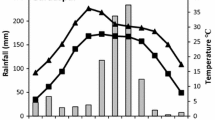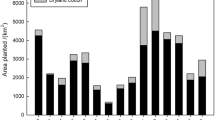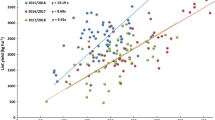Abstract
Nitrogen (N) management strategies for cotton may need to be modified because of the use of new high yielding cultivars and improved cropping systems. The objective of this research was to determine the optimal N application rate and critical leaf N concentration for contemporary high yielding cotton under no-tillage systems. A strip-plot trial was conducted on eleven private farms in Crockett, Fayette, Gibson, Haywood, Lake, and Lauderdale counties from 2009 through 2010 in Tennessee. Five N treatments of 0, 45, 90, 134, and 179 kg N ha−1 were evaluated as side-dress N of urea and ammonium nitrate solution in strip plots in a randomized complete block design with three replicates. Eight out of the eleven location–years showed significant yield responses to side-dress N applications. Applying 45–146 kg N ha−1 (including pre-plant and side-dress N) was sufficient for maximum cotton yields at the N responsive location–years. The results of this study indicate that the current N fertilizer recommendations for cotton may be more than adequate for some upland soils but inadequate for some other upland fields. A range of 34.4–47.4 g kg−1 of leaf N concentration at early bloom is required for cotton to reach to maximum lint yield. These critical leaf N values were somewhat greater than the current sufficient N range, which suggests that the current critical leaf N concentrations for cotton in the southern U.S. may need to be modified; contemporary high yielding varieties require slightly higher N application rates to maximize yields.









Similar content being viewed by others
References
Bell PF, Boquet DJ, Millhollon E, Moore S, Ebelhar W, Mitchell CC, Varco J, Funderburg ER, Kennedy C, Breitenbeck GA, Craig C, Holman M, Baker W, McConnell JS (2003) Relationships between leaf-blade nitrogen and relative seedcotton yields. Crop Sci 43:1367–1374
Bondada BR, Oosterhuis DM (2001) Canopy photosynthesis, specific leaf weight, and yield components of cotton under varying nitrogen supply. J Plant Nutr 24:469–477
Boquet DJ (2005) Cotton in ultra-narrow row spacing: plant density and nitrogen fertilizer rates. Agron J 97:279–287
Boquet DJ, Breitenbeck GA (2000) Nitrogen rate effect on partitioning of nitrogen and dry matter by cotton. Crop Sci 40:1685–1693
Boquet DJ, Moser EB, Breitenbeck GA (1993) Nitrogen elects on boll production of field grown cotton. Agron J 85:34–39
Bronson KF, Onken AB, Keeling JW, Booker JD, Torbert HA (2001) Nitrogen response in cotton as affected by tillage system and irrigation level. Soil Sci Soc Am J 65:1153–1163
Campbell CR, Plank CO (2011) Corn. In: C.R. Campbell (ed), Reference sufficiency ranges for plant analysis in the southern region of the United States. South Coop. Ser. Bull. 394. South. Region Agric. Experiment Stn., NC. p. 15–18
Cisneros JJ, Godfrey LD (2001) Midseason pest status of the cotton aphid (Homoptera:Aphididae) in California cotton: Is nitrogen a key factor? Environ Entomol 30:501–510
Fritschi FB, Roberts BA, Travis RL, Rains DW, Hutmacher RB (2004) Seasonal nitrogen concentration, uptake, and partitioning pattern of irrigated Acala and Pima cotton as influenced by nitrogen fertility level. Crop Sci 44:516–527
Gerik TJ, Jackson BS, Stockle CO, Rosenthal WD (1994) Plant nitrogen status and boll load of cotton. Agron J 86:514–518
Gerik TJ, Oosterhuis DM, Tolbert HA (1998) Managing cotton nitrogen supply. Adv Agron 64:115–147
Harris G, Baker S (1997) Nitrogen management for cotton following cotton on Coastal Plain soils. In Proc. Beltwide Cotton Conf. National Cotton Council of America, Memphis, TN, p. 576–577
Howard DD, Hoskinson PE (1986) Nitrogen fertilization of cotton: rate and time of applications on a Loring silt loam soil. Tenn Farm Home Sci 138:13–16
Howard DD, Hoskinson PE (1990) Nitrogen recommendations for cotton and how they were developed in Tennessee. In: Miley WN, Oosterhuis DM (eds) Nitrogen nutrition of cotton: Practical issues. ASA, Madison, pp 47–52
Howard DD, Gwathmey CO, Essington ME, Roberts RK, Mullen MD (2001) Nitrogen fertilization of no-till cotton on loess-derived soils. Agron J 93:157–163
Hoyt GD, Hargrove WL (1986) Legume cover crops for improving crop and soil management in the southern United States. HortScience 21:397–402
Hutchinson RL, Breitenbeck GA, Brown RA, Thomas WJ (1995) Winter cover crop effects on nitrogen fertilization requirements of no-till and conventional-tillage cotton. In: McClelland MR et al (eds) Conservation-tillage systems for cotton: A review of research and demonstration results from across the Cotton Belt. Arkansas Agric. Exp. Stn, Fayetteville, pp 73–76
Hutmacher RB, Travis RL, Rains DW, Vargas RN, Roberts BA, Weir BL, Wright SD, Munk DS, Marsh BH, Keeley MP, Fritschi FB, Munier DJ, Nichols RL, Delgado R (2004) Response of recent Acala cotton cultivars to variable nitrogen rates in the San Joaquin valley of California. Agron J 96:48–62
Johnston AE (2000) Efficient use of nutrients in agricultural production systems. Commun Soil Sci Plant Anal 31:1599–1620
Main CL, Barber LT, Boman RK, Chapman K, Dodds DM, Duncan S, Edmisten KL, Horn P, Jones MA, Morgan GD, Norton ER, Osborne S, Whitaker JR, Nichols RL, Bronson KF (2013) Effects of nitrogen and planting seed size on cotton growth, development, and yield. Agron J 105:1853–1859
Maples R, Keogh JG (1971) Cotton fertilization studies on loessial plains soils of eastern Arkansas. Univ Ark Agric Exp Stn Bull 825
McConnell JS, Baker WH, Miller DM, Frizzell BS, Varvil JJ (1993) Nitrogen fertilization of cotton cultivars of differing maturity. Agron J 85:1151–1156
Mehlich A (1984) Mehlich 3 soil test extractant: a modification of Mehlich 2 extractant. Commun Soil Sci Plant Anal 15:1409–1416
Meredith WR Jr, Heitholt JJ, Pettigrew WT, Rayburn ST Jr (1997) Comparison of obsolete and modern cotton cultivars at two nitrogen levels. Crop Sci 37:1453–1457
Miley WN (1974) Fertilizing cotton with nitrogen. Ark. Coop. Ext. Serv, Leaflet 526
Moore SH (1999) Nitrogen effect on position of harvestable bolls in cotton. J Plant Nutr 22:901–909
Overton JR, Long OH (1969) Responses of corn and cotton to fertilizer on Loring and Calloway soils. Tenn Farm Home Sci 68:24–28
Pettigrew WT, Adamczyk JJ (2006) Nitrogen fertility and planting date effects on lint yield and Cry1Ac (Bt) endotoxin production. Agron J 98:691–697
Pettigrew WT, Zeng L (2014) Interactions among irrigation and nitrogen fertility regimes on mid-south cotton production. Agron J 106:1614–1622
Prasad R, Power JF (1995) Nitrification inhibitor for agriculture, health and environment. Adv Agron 54:233–281
Reeves DW (1994) Cover crops and rotations. In: Hatfield JL, Stewart BA (eds) Advances in soil science: Crops residue management. Lewis Publ, Boca Rotan, pp 125–172
Savoy HJ, Joines D (2009) Lime and fertilizer recommendations for the various crops of Tennessee. Chapter II. Agronomic crops. http://soilplantandpest.utk.edu/pdffiles/soiltestandfertrecom/chap2-agronomic_mar2009.pdf. Accessed 21 Jul 2015
Tewolde H, Fernandez CJ (1997) Vegetative and reproductive dry weight inhibition in nitrogen- and phosphorus-deficient Pima cotton. J Plant Nutr 20:219–232
Acknowledgments
This project was supported by Cotton Incorporated Cooperative Agreement No. 09-497TN, managed by Dr. Robert L. Nichols. We appreciate the cooperative farmers: Ryan Gorley (Crockett County), Bill Walker (Fayette County), Jeff Dodd (Gibson County), Bradley Booth (Haywood County), John Lindamood (Lake County), and Eugene Pugh (Lauderdale County) for allowing us to conduct tests on their farms. Technical assistance was provided by Robert Sharp, James Warren, Tracy Bush, Matthew Ross, Ngowari Jaja, Will Goforth, and others.
Author information
Authors and Affiliations
Corresponding author
Rights and permissions
About this article
Cite this article
Yin, X., Main, C. Nitrogen fertilization and critical nitrogen concentration for contemporary high yielding cotton under no-tillage. Nutr Cycl Agroecosyst 103, 359–373 (2015). https://doi.org/10.1007/s10705-015-9751-0
Received:
Accepted:
Published:
Issue Date:
DOI: https://doi.org/10.1007/s10705-015-9751-0




